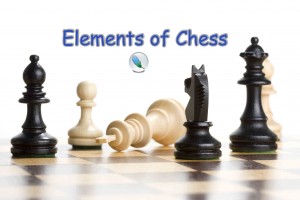
Chess is a board game played between two players with 32 pieces distributed equally between them. The pieces include one King, one Queen, 2 bishops, 2 knights, 2 rooks and 8 pawns, thus making 16 pieces. One set of 16 pieces are in white color, while the other set of pieces will be in black. The primary objective of the game is to capture the King of the other member through the means of checkmate. In other words, the objective of the person using the White pieces is to capture the black king, while the objective of the person using the black pieces is to capture the White king
Before going further about the concepts of king, checkmate and such other things, let us dwell on the basic elements to have a better understanding of the game. The basic requirement for playing chess is a square board with 64 squares in it. The 64 squares are arranged in equal number of rows and columns. In other words, the chessboard has eight rows and eight columns, thus making it 64 squares in all. The 64 squares are alternatively colored in black and white, which makes it easier for distinguishing the moves of the pieces. The columns, or vertical rows as otherwise called, are referred to as “files” and the horizontal rows or simply rows are called as “ranks”, in chess parlance.
The “files” are named in alphabets such as “a”, “b”, “c”, up to “h”, and the “ranks” are given the numbers from 1 to 8. The concepts of the board and the nomenclature are very essential for any person aspiring to learn chess and gain mastery over it. Each square is referred as a combination of the “rank” and the “file”. Thus, “a1” refers to the first square on the left hand bottom corner of the board, while “h8” refers to the top right corner of the board.
Now, we have the chessboard in front of us and we understood what does the columns and rows there refer to and how we should call them. The next thing we should know is “how to place the board in the table?” Before starting to play chess, one should know where and how to place the chessboard in the table. I have already stated that the columns and rows in the board are filled with alternative colors – white and black. The board should be placed in the middle of the table with the two players facing each other. The board should be placed such that there is a white square in the corner on each player’s right hand side. Using the nomenclature above to identify the squares, we can say that the respective white squares at the right corners of the players would be “h1” and “a8”.
The next thing is the arrangement of the pieces in the board. As already stated, two sets of 16 pieces, in alternate colors, are used for playing chess. One player uses the white pieces while the other has to use the other color. Recall that the chessboard has 64 squares. Each player now has 16 pieces at his/her disposal. The person using white pieces has to use the ranks 1 and 2 to arrange the pieces while the player sitting on the other side will have to use the ranks 7 and 8 to arrange the pieces.
The ranks in the middle, viz., 3, 4, 5 and 6 are left empty before starting the gaming or after arranging the pieces in a set order. The empty squares or the “space” left blank has its own relevance. For the person playing white, the ranks 1 and 2 having pieces in them and the empty spaces in ranks 3 and 4 are his/her territory, or “white territory”, and for the person playing black, the ranks 7 and 8 with pieces and empty space in ranks 5 and 6 are his/her territory, or “black territory”.
Let me share with you one interesting concept at this stage. Chess is also referred to as a game of “spatial conquest”. At the start of play, both the players start with the same number of pieces and the same amount of empty space. Depending on the skill with which you maneuver the empty space, the probability of your success over the opponent is determined. Assuming that you are playing white, the ranks 5, 6, 7 and 8 will be somewhat like enemy territory in a battlefield, while for the player using black pieces, ranks, 1, 2, 3, and 4, used by you, will be the enemy territory for him.
Imagine yourself as the king of an army and you are entering into a war with another king having an army of similar strength as yours and both of you are entering into a battlefield to settle the issue. Here your army is the 16 pieces and the battlefield is the chessboard.
How does the idea sound? It is for this very reason, Chess is considered one of the most fascinating board games opening up more and more avenues for innovation as you experiment and gain adequate experience.
Having briefed about the basic elements about the game of chess, let me turn my attention to the details of the pieces, their positions, relative value and importance and their scope of movement in the game.


Trackbacks/Pingbacks